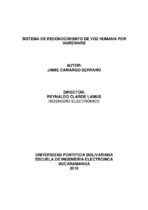Mostrar el registro sencillo del ítem
Sistema de reconocimiento de voz humana por hardware
| dc.contributor.advisor | Lamus, Jaime Camargo | |
| dc.contributor.author | Camargo Serrano, Jaime | |
| dc.coverage.spatial | Seccional Bucaramanga. Universidad Pontificia Bolivariana. Escuela de Ingenierías. Facultad de Ingeniería Electrónica | spa |
| dc.coverage.temporal | 2010 | |
| dc.date.accessioned | 2013-08-28T16:59:33Z | |
| dc.date.available | 2013-08-28T16:59:33Z | |
| dc.date.created | 2010-08-03 | |
| dc.date.issued | 2013-08-28 | |
| dc.identifier.uri | http://hdl.handle.net/20.500.11912/833 | |
| dc.description | 106p.: (pdf); il; tablas; anexos | spa |
| dc.description.abstract | El crecimiento o avance de la tecnología ha generado la utilización de nuevas maneras de interactuar con sistemas robóticos en diferentes campos como la industria automotriz, la medicina, la industria militar, las comunicaciones etc., de ahí que se puedan operar brazos robóticos en la industria automotriz, hasta operar un brazo en la luna; también en medicina para realizar procedimientos tele operados. En el presente trabajo se realiza la descripción de un sistema de Reconocimiento Autónomo de Habla (RAH), el cual permite registrar, validar, identificar y generar acciones a partir de palabras o frases básicas. Específicamente en el caso del proyecto desarrollado, se ha elegido un sistema basado en hardware (circuitos integrados especializados), los cuales permiten desarrollar aplicaciones stand-alone (independientes). En este orden de ideas, se ha realizado una fuerte revisión del estado del arte sobre el tema de Reconocimiento de Voz; destacando tres topologìas: Comparación de Patrones, Modelos Ocultos de Markov y Redes Neuronales Artificiales. Los trabajos mas destacados a nivel Colombia se centran en la detección de voz para controles robóticos, parametrización del habla para detección de patologías, aplicaciones para el apoyo a personas con discapacidad auditiva, entre otros. Basado en la revisión descrita anteriormente, el proyecto permitió verificar cerca de 5 opciones de dispositivos hardware para cumplir con los requerimientos; donde los criterios de elección fueron bajo consumo de potencia, bajo costo y capacidad para gestionar hasta 20 palabras independientes. En ese sentido, se ha escogido el integrado HM2007, el cual cumple con un funcionamiento bastante acertado para el control del brazo robótico (eje central del apoyo a los discapacitados). Como resultados, observar que es recomendable utilizar pruebas con el mismo hablante, que garantiza una efectividad de funcionamiento superior al 95%. Además, las palabras utilizadas deben tener diferencias fonéticas considerables, para evitar problemas de funcionamiento. | spa |
| dc.description.abstract | The growth or progress of technology has led to the use of new ways to interact with robotic systems in different fields such as automotive, medical, military, communications and so on., So they are able to operate robotic arms industry automobile, to operate an arm on the moon, also in medicine for tele-operated procedures. In the present study is the description of a system of Self Speech Recognition (ASR), which allows you to record, validate, identify and generate action from basic words or phrases. Specifically in the case of the project developed, we have chosen a system based on hardware (specialized integrated circuits), which allows develop applications stand-alone (independent). In this vein, it has made a major revision of the state of the art on the subject of voice recognition, highlighting three topologies: Comparison of Patterns, Hidden Markov Models and Artificial Neural Networks. Work Colombia\'s foremost focus on the detection of voice for robotic controls, customizing speech pathology detection, applications for support for people with hearing disabilities, among others. Based on the review described above, the project allowed us to verify about 5 choices of hardware devices to meet the requirements, where the selection criteria were low power consumption, low cost and ability to manage up to 20 independent words. In this regard, we have chosen the integrated HM2007, which fulfills a very successful operation to control the robotic arm (central axis of support for the disabled). As a result, note that you should use tests with the same speaker, ensuring operational effectiveness above 95%. Furthermore, the words used must have considerable phonetic differences, to avoid operational problems. | |
| dc.language.iso | es | |
| dc.publisher | Universidad Pontificia Bolivariana | spa |
| dc.rights | Attribution-NonCommercial-NoDerivatives 4.0 International | * |
| dc.rights.uri | http://creativecommons.org/licenses/by-nc-nd/4.0/ | * |
| dc.subject | Tesis y disertaciones académicas | spa |
| dc.subject | Ingeniería electrónica | spa |
| dc.subject | Redes neurales | spa |
| dc.subject | Circuitos integrados | spa |
| dc.subject | Redes neurales artificiales | spa |
| dc.title | Sistema de reconocimiento de voz humana por hardware | spa |
| dc.type | bacherlorThesis | spa |
| dc.rights.accessRights | openAccess | spa |
| dc.type.hasVersion | publishedVersion | spa |
| dc.identifier.instname | instname:Universidad Pontificia Bolivariana | spa |
| dc.identifier.reponame | reponame:Repositorio Institucional de la Universidad Pontificia Bolivariana | spa |
| dc.identifier.repourl | repourl:https://repository.unab.edu.co/ |
Ficheros en el ítem
Este ítem aparece en la(s) siguiente(s) colección(ones)
-
Trabajos de grado [6698]
Monografías, artículos, informes, proyecto de grado


